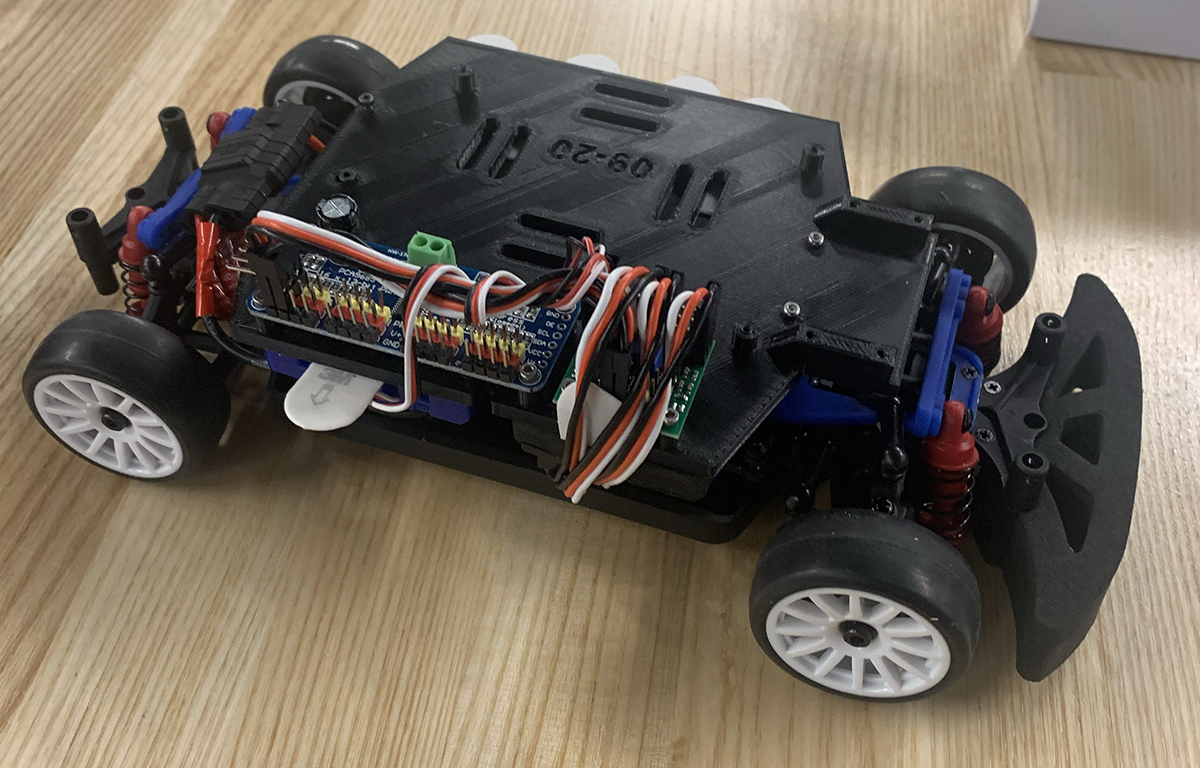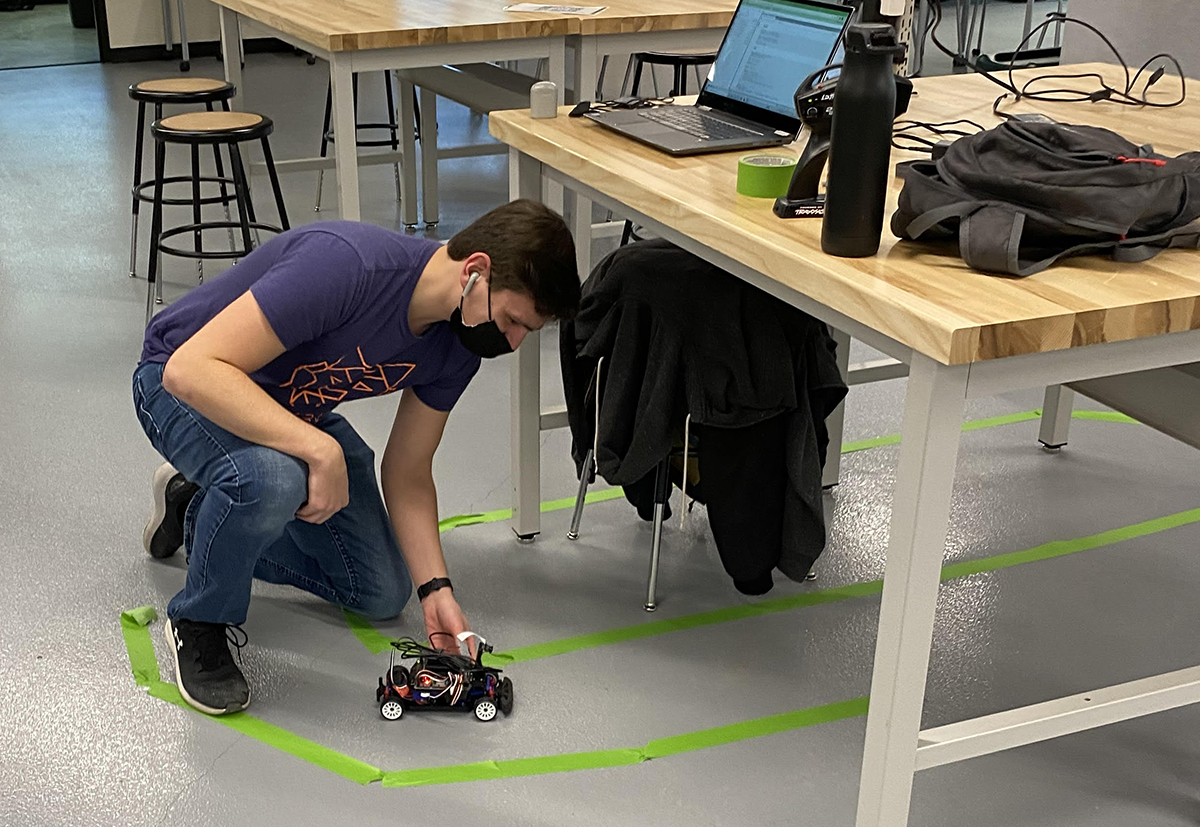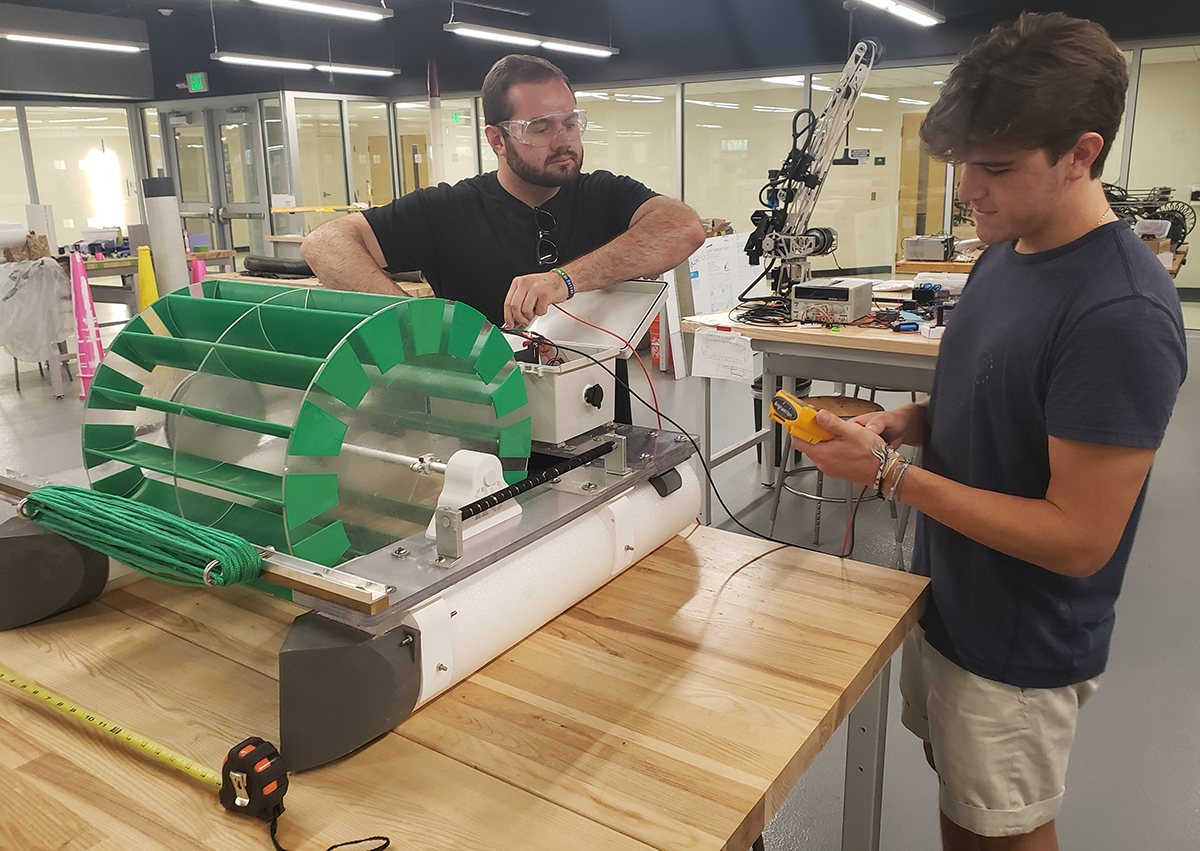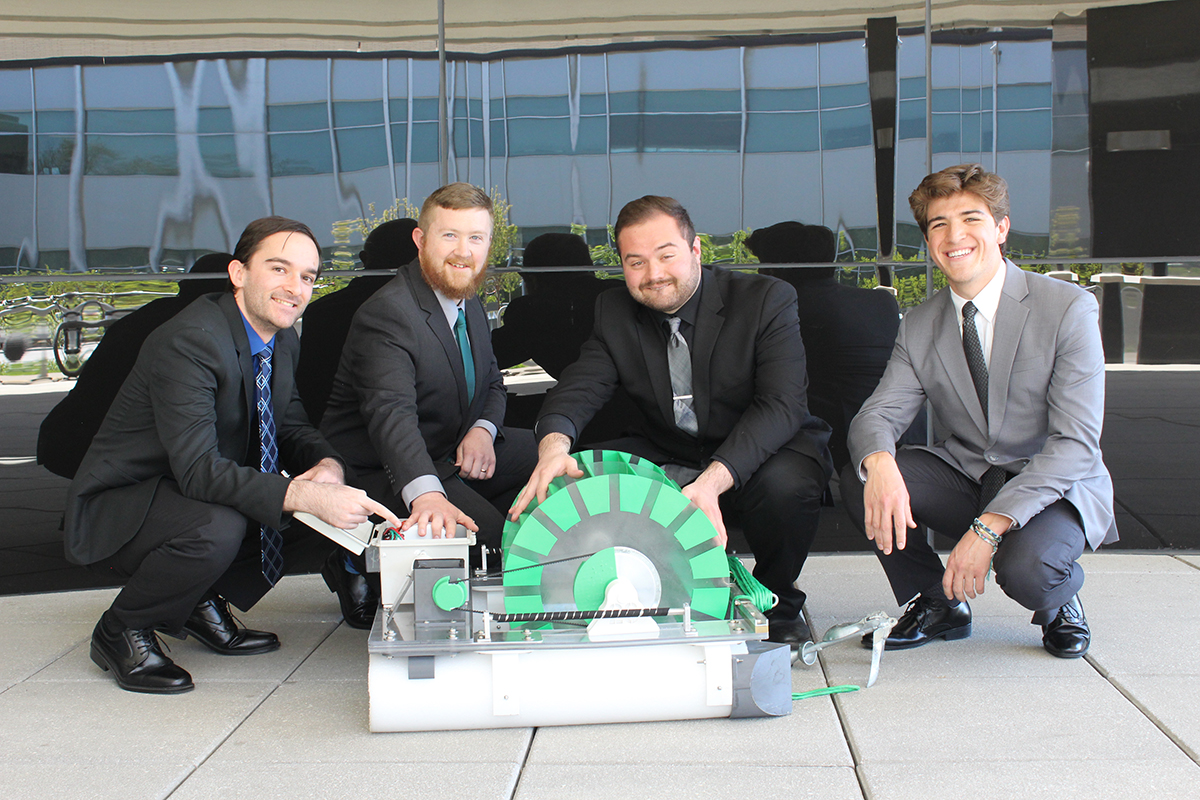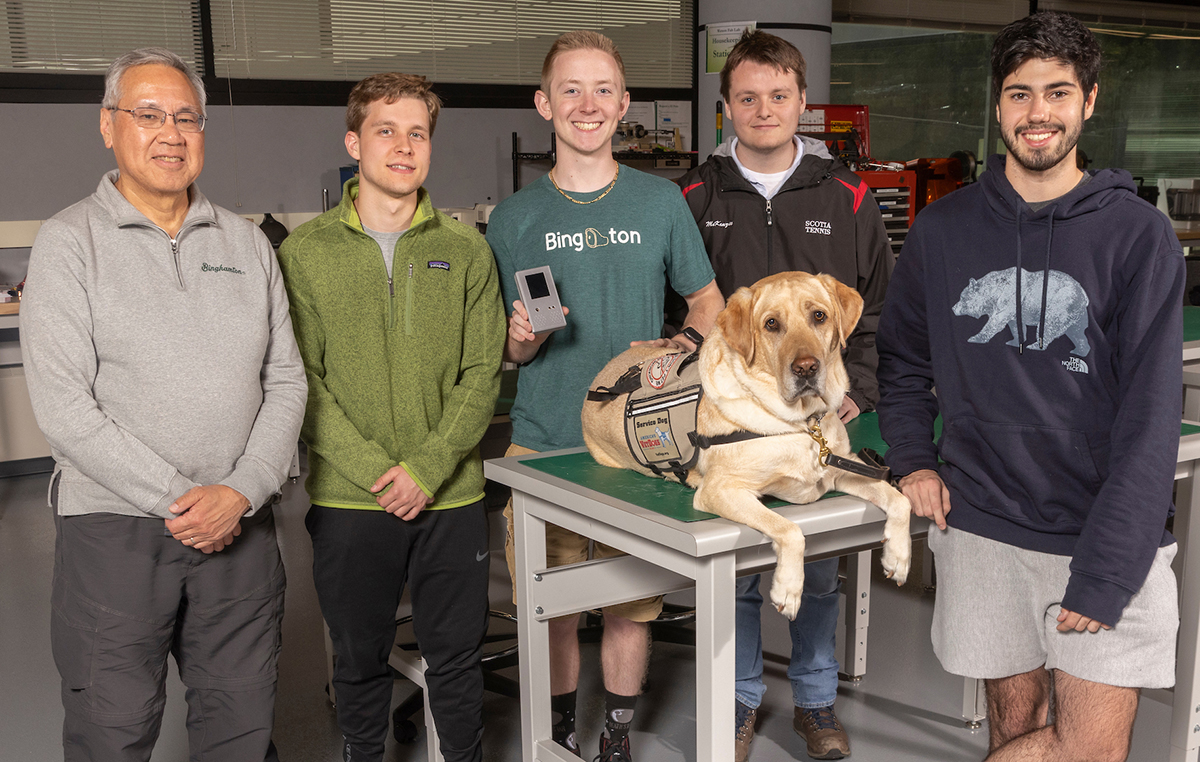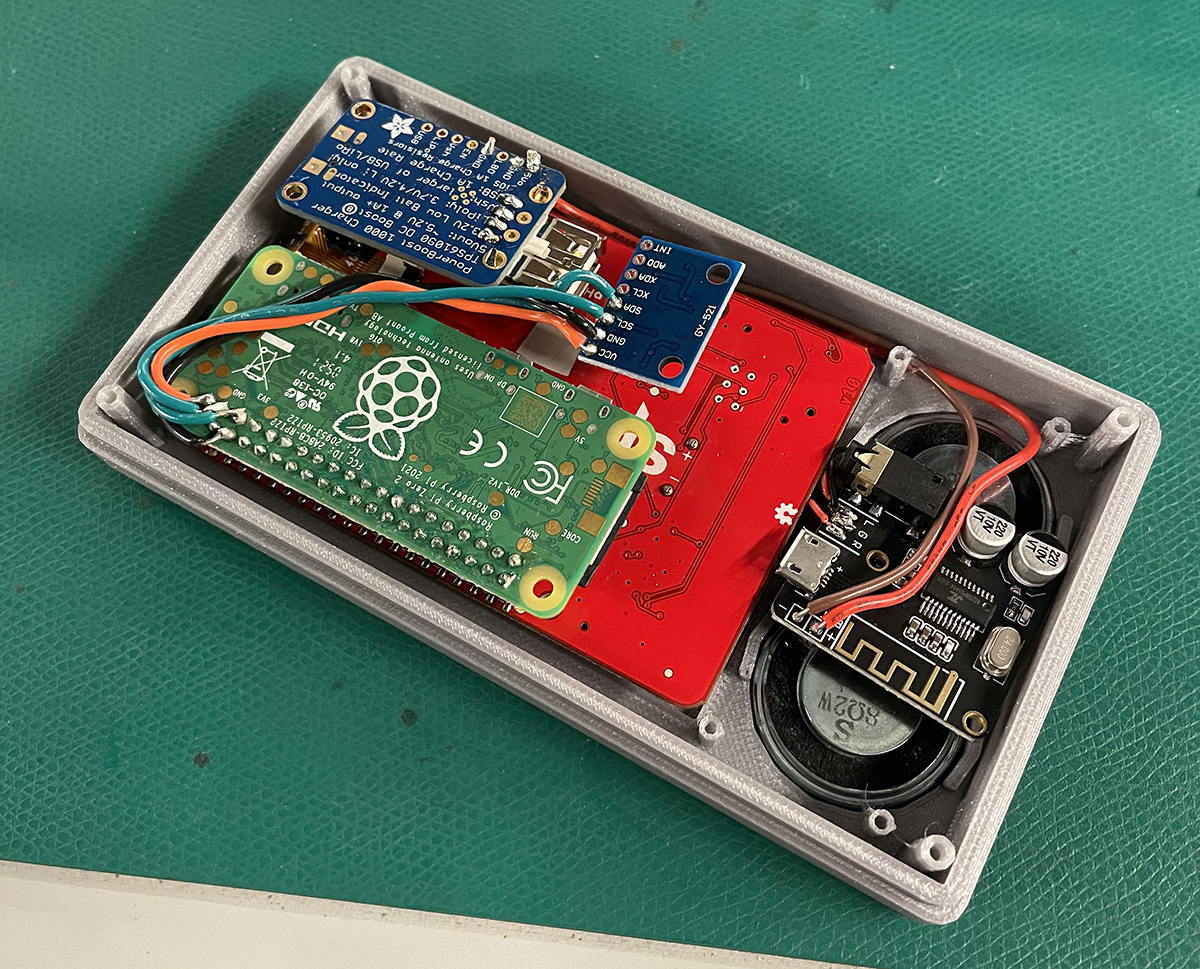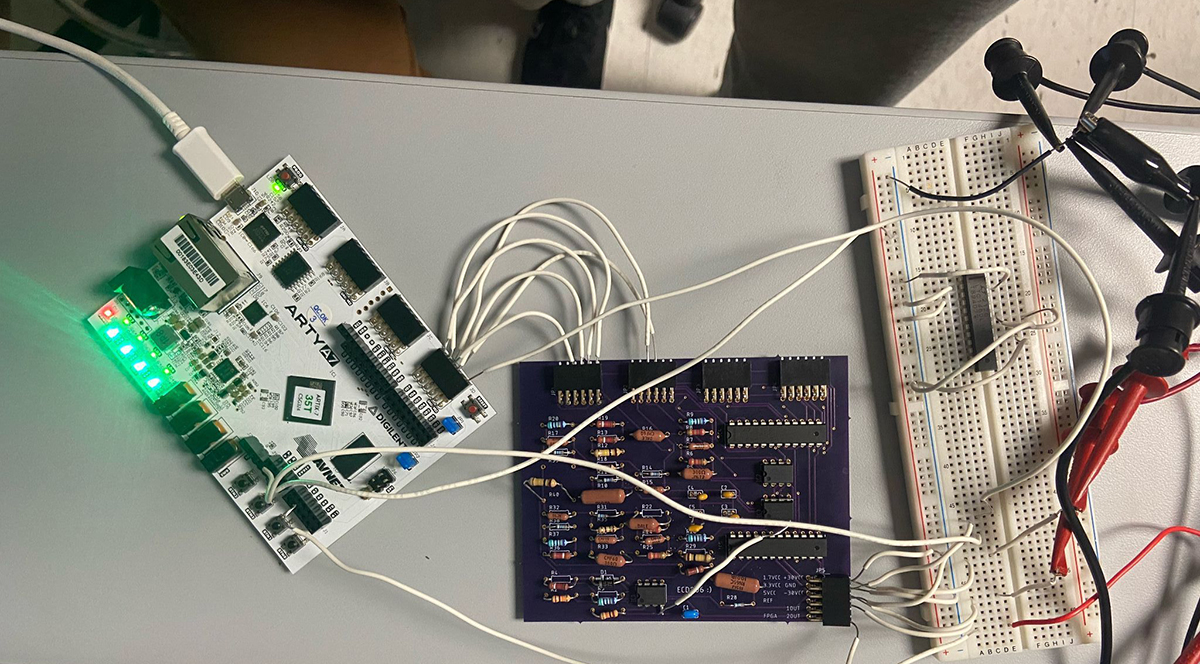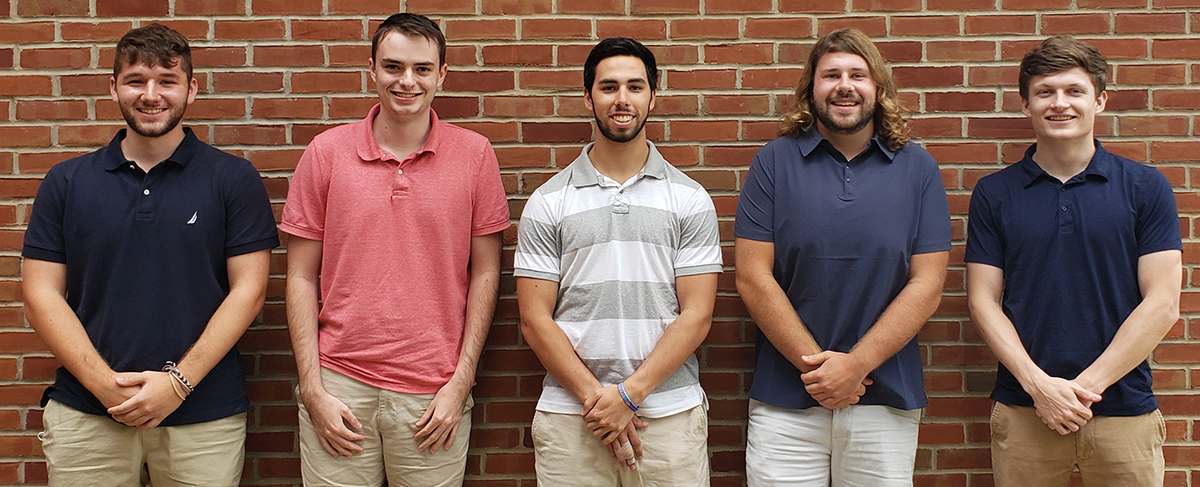Partners for innovation: Industry and government sponsor Watson College senior projects
BAE Systems, Lockheed Martin, AVANGRID and Naval Nuclear Laboratory offer funding, assign mentors
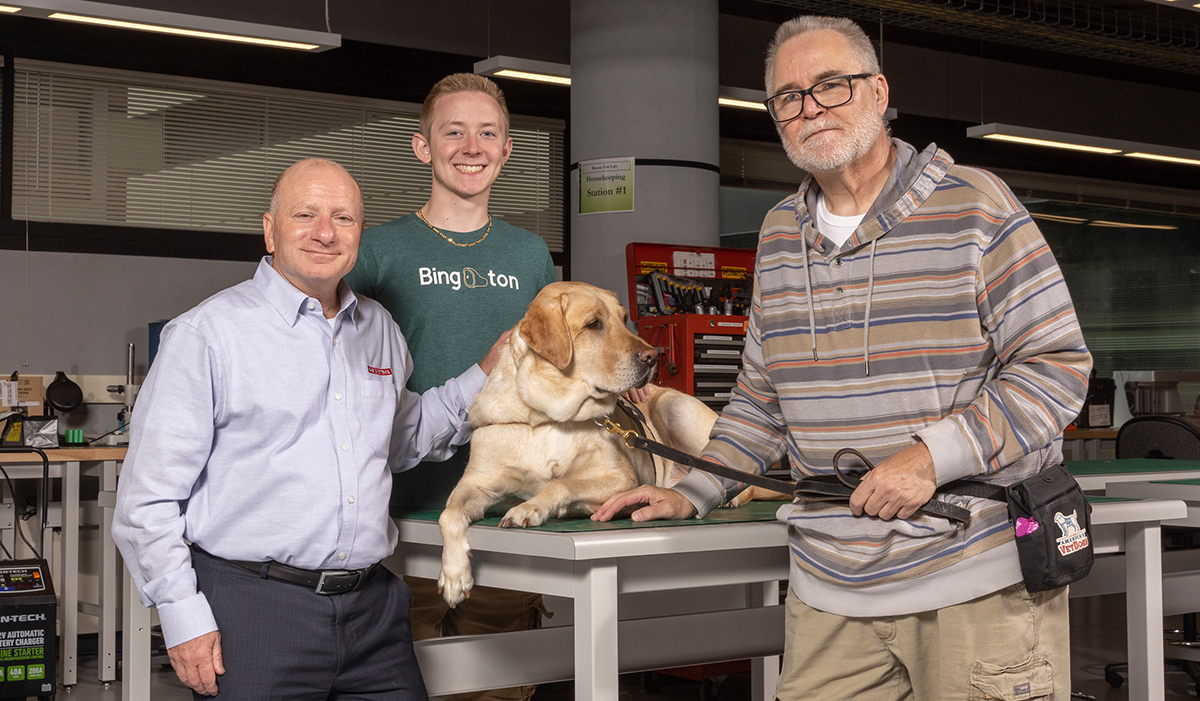
Before receiving their bachelor’s degrees, Watson College students spend hundreds of hours in classrooms and labs learning engineering and computer science skills.
In their senior year, most undergraduates also get a taste of what it’s like to work in industry through capstone projects. Students are assigned to teams of a half-dozen or so with specific objectives. They need to stay on track, deal with any setbacks, manage a budget, deal with a “boss” (faculty advisor), produce a product by the end of the spring semester and make a presentation explaining their work.
Some projects have corporate and government partners, including BAE Systems, Lockheed Martin, AVANGRID and the Naval Nuclear Laboratory. They generously offer funding and assign mentors to help guide projects through to completion. We appreciate their support!
How does this corporate/student partnership work? We asked participants on both sides of the equation to share their experiences.
Exploring artificial intelligence with Lockheed Martin
Tom Gaska, MS ’00, remembers the first year he served as a mentor for a Watson capstone team. It was 2004, and the 12 students took a Power Wheels children’s car and tried to make it an autonomous vehicle, complete with a laptop “brain” and GPS. He admits that they “didn’t get very far” — the technology wasn’t quite there yet — but the project did go to Albany for a statewide showcase about student innovation.
During the 2021-22 academic year, he guided a five- person team with another autonomous car project — this time modifying a radio-controlled vehicle and utilizing the latest in artificial intelligence. With improved tech and seniors eager to use it, this attempt proved more successful.
Gaska — a computer system architect at Lockheed Martin in Owego, N.Y. — looks back on his time as a mentor with fondness: “It’s been a journey, but it’s also been a lot of fun.”
Every fall semester starts with a list of projects. Industry partners define the parameters for the ones they sponsor, professors come up with other projects and some carry over from year to year. Students give their preferences, and faculty members assign who works on which idea.
In 2021–22, Lockheed Martin sponsored five projects, including a specialized video display, an open-sourced drone and software to control swarms of small robots.
One of the first steps is figuring out roles. Jared Tyler ’22 served as team leader for the 2021-22 autonomous car project that Gaska and Tom Norton (a machine learning/fusion architect at Lockheed Martin) mentored. Other members were Benjamin Zhang ’22, Clifford Rood ’21, Joseph Irish ’22 and Kory Morrison ’22, with Assistant Professor Wenfeng Zhao from the Department of Electrical and Computer Engineering as faculty advisor.
“I have always been fascinated with machine learning,” Tyler says. “It can be applied to so many different things — for this project, it runs an autonomous vehicle, but it can also be applied to things like forecasting the weather or predicting what songs you might like.”
He and his team researched autonomous RC cars before deciding to use a NVIDIA Jetson processor, which provided the necessary computing power and fit within the project’s budget. They used masking tape on the floor of the Fabrication Lab in the Engineering Building as a track for the car to follow.
“With a fairly small amount of data — around 100 images — we were able to detect the boundaries of the track,” Tyler says. “And with 200 to 300 images, we could move the car accordingly.”
The senior team had monthly meetings with Gaska and Norton, and students would call on their mentors any time they had a problem they couldn’t overcome on their own. If Gaska and Norton don’t know the answer, they can tap into the international resources that Lockheed Martin offers.
“Sometimes they’ll get stuck on something and they don’t know how to get past it,” Gaska says. “If you don’t help them, they could spend two months still stuck on the same step, so that support is very important.”
Sometimes a senior project will be a continuation from the year before. Zach Zelker ’21 led one like that under Gaska’s mentorship during the 2020-21 academic year, improving a video interface intended for a helicopter’s radar display.
“The previous group defined the hardware that we would use, because they had already purchased some of it,” he says. “We had to get familiar with the software, so that was a big learning curve. Once we were somewhat comfortable with the software, we were able to break down the different functionality that we needed, create some finite-state machines for that, and then implement them, test them and cycle through that process.”
Making industry connections also aids students’ post-graduation employment prospects. Both Tyler and Zelker started jobs at Lockheed Martin this fall. Tyler did undergraduate internships at the company and will work as a firmware engineer, and Zelker accepted a position as a software engineer.
When jumping into industry, Tyler, Zelker and other Watson graduates take the skills learned not only in classrooms but also from the senior projects and similar hands-on experiences.
“There isn’t a single project on the [senior capstone] list that you can jump into and make right off the bat,” Tyler says. “You have to get more knowledge, you have to talk to people and you have to work through the bugs. That’s one of the best parts of these senior projects — learning how to learn.”
As a mentor, Gaska feels he benefits by working with Watson students: “If you’re interested in an area that as a Lockheed Martin employee you’re not working in, you get exposure to it and maybe you find out that you want to do that next.”
Zelker also believes that corporate support aids both students and mentors: “Having people from industry involved with it, with their connections and everything, offers a whole other layer of benefits. Getting more projects that are sponsored, like the one that I did, would be very valuable.”
Pursuing renewable energy with AVANGRID
As a leading clean-energy company in the U.S., AVANGRID Inc. understands the need to accelerate the transformation to renewable, affordable energy sources. Only a coordinated, global effort to address climate change can ensure the future of the Earth.
That’s why AVANGRID — parent company to New York State Electric & Gas (NYSEG), which supplies power to thousands of customers in Binghamton and surrounding areas — supports Watson senior projects, to nurture the future of engineering and computer science to create the energy solutions of tomorrow.
“We believe that it’s the people who make us a better company and that an educated and skilled workforce benefits society as a whole,” says Pablo Colón, director of corporate citizenship at AVANGRID and executive director of the Avangrid Foundation.
“By making investments in education where we serve our customers, we’re helping to build stronger communities. We have deep roots in Binghamton — NYSEG has been part of this community for more than 100 years. We’re very proud to have strong educational institutions like Binghamton University and Watson College right here in our backyard and to have many talented alumni as part of our team.”
During the 2021-22 academic year, AVANGRID sponsored 17 senior projects, from bacteria- powered batteries and smart meters to solar-panel tracking, a wearable monitor for air pollution, and a microcontroller for a solid-state transformer.
Tom Eaton ’22 led one of three projects tasked with designing and building a portable hydroelectric plant. His teammates were Benjamin St. Claire ’22, Liam Vallejo ’22 and David Fredericks ’22, with lecturer Colin Selleck from the Department of Mechanical Engineering as advisor.
As first steps after the getting-to-know-you phase, Eaton and his team closely studied the project parameters, which included producing 12 volts of power. He tasked each of them to imagine the hydro-generator in broad strokes, and then they integrated the best ideas into a final design within the allotted budget.
“I enjoy the creative aspect of engineering, because I think of it as an art form,” Eaton says. “There are no blueprints already drawn up for something in your brain — you have to come up with that.”
While other teams with the same objectives built less powerful devices, Eaton and his collaborators decided to “kick up the horsepower a lot,” which led to a 2.5-by-2.5- by-2-foot generator capable of producing 100 watts — enough to power small devices such as cell phones, laptops, Wi-Fi routers and lamps.
Waterproofing the generator proved to be as challenging as its electrical aspects. The team ran an early version under a hose outside the Engineering Building — getting odd looks from passing tour groups — and later tested it in the West Gym pool to make sure it could float, using a motor with wheels of different diameters to simulate the minimum and maximum flow requirements.
In late March, they headed to downtown Binghamton, anchored the generator to a bridge and set sail on the Susquehanna River.
“It worked on the first try!” Eaton says. “In our original timeline, I gave us about a month and a half for redesigns, rebuilding and retesting, but that was unnecessary. I think this might be the first engineering project — at least I’ve ever worked on — that was ahead of schedule.”
Remote learning due to COVID-19 meant that many students in 2021-22 didn’t know each other very well before becoming teammates. While different opinions can spark ideas, Eaton and his fellow team leaders must defuse any conflicts early before they derail the design process.
“You need to be conscious of others’ feelings and know how they are reacting to stuff,” he says. “I was very fortunate. I became good friends with everyone on my team. We’re happy with how the project turned out, and we all had a good time working with each other.”
Eaton returned to Binghamton University this fall for his MBA at the School of Management, and he hopes to work in project management at an engineering firm.
Patricia Patterson ’12, MS ’13, the principal engineer for NYSEG’s Energy Control Center, appreciates how a Watson College education launched her career.
“Speaking from experience, the senior capstone projects help engineering students learn to work closely with engineers in different disciplines,” she says. “The students greatly benefit from interaction with individuals in industry as well as dedicated time with professors and other field experts absorbing invaluable knowledge from those with significant experience. This experience aids students for years to come as they transition from a university setting to a real-world project setting.”
Colón believes that building those relationships between industry and students through financial sponsorship helps both Watson College and AVANGRID.
“As a member of a global group, it is critical that we’re able to attract the best and brightest talent,” he says. “To do so, we want to engage with best-in-class partners. Watson College’s senior capstone projects are attractive to us because of their positive and effective impact on students to prepare them to enter the workforce.”
Assisting veterans, service dogs with BAE Systems
Through corporate giving, employee giving and employee volunteerism, BAE Systems is proud to innovate for veterans, inspire students and invest in its communities.
BAE Systems works with Binghamton University as part of its Tech Power: Innovating for Impact program, which leverages undergraduate engineering students’ expertise to create assistive technology solutions for disabled veterans.
“We aim to inspire undergraduate engineering students from top universities nationwide to collaborate with our mentors and apply their skills toward human- centered, real-world projects that enhance the well-being and independence of veterans with disabilities,” says Amy Sweeney, head of community investment, BAE Systems Electronic Systems sector.
In 2021-22, two teams of students worked on BAE Systems-sponsored senior projects through America’s VetDogs, a national nonprofit that enhances mobility and independence for veterans, active-duty service members and first responders with disabilities.
“We do a lot of work for the U.S. government and the military,” says Tom D’Onofrio, director of quality for BAE Systems’ power and propulsion solutions business area in Endicott, N.Y. “One of our mottos is ‘We Protect Those Who Protect Us,’ and we recognize the importance of the sacrifices made by our active- duty military men and women, our veterans and their families.”
D’Onofrio and Mrinal Iyengar, senior director of engineering at BAE Systems, served as mentors for a project that developed a portable and wireless medical- alert device that enables a disabled person, in conjunction with a service dog, to summon help in case of a fall.
Eric Matson ’22 led teammates Miguel Fana ’22, Preksha Gupta ’22, Dominick Cosentino ’22 and Cristian Clara ’22. Art Law, associate director of capstone design for Watson’s Department of Electrical and Computer Engineering, was the team’s advisor.
Although the device could have wider potential, the team developed it for one specific customer: John Coulton, a U.S. Army veteran from Hunlock Creek, Pa., and his service dog Colonel Dave.
Matson and his team — which included biomedical, electrical and computer engineering majors — learned what Coulton wanted before working up design ideas. Using the open-source Raspberry Pi processor, they developed an iPhone-sized device with an intuitive user interface.
Along the way, they met virtually with mentors every other week, with one-on-one sessions in between to address technical issues. They also checked in with Coulton to show their progress and hear his feedback.
“I was really impressed by the project team — they were hard-working students and extremely intelligent and creative, and I enjoyed trying to help them wherever we could,” Iyengar says. “We were able to bring in experts from other areas of BAE Systems who were not part of the mentoring team, but they volunteered to help the students with some hard problems. I hope it was very fruitful for the students. I know it was very fruitful for the mentors.”
Working for a specific customer on something with personal safety implications spurred Matson and his teammates to work that much harder.
“There’s an actual person I’m going to help with this design, if he’s ever in trouble when nobody else is there,” Matson says. “He’s more than a name on the project proposal. We got to know him and Colonel Dave — they’re both very nice. It makes you want to put in those extra two hours to get that last bit of code to compile correctly.”
While some projects end after one academic year, a new team of seniors will continue to work on the portable medical alert device in 2022-23. Matson — who returned to Binghamton this fall to earn his ECE master’s degree through Watson’s 4+1 program — will offer advice as needed.
“The device uses algorithms and a gyro/accelerometer to determine whether a medical emergency event has occurred,” D’Onofrio says. “This year’s project is to take those algorithms and perfect them so that we don’t have any false positives or false negatives. There also were limitations with the processor, so we want to see if we can push through those restrictions.”
A “stretch goal” for this year’s team is to make the buttons on the device usable for a dog’s nose as well as human fingers, so Colonel Dave could be trained to trigger it in an emergency.
“This device, along with Colonel Dave, makes me feel safe, especially going out in public,” says Coulton, who served in the Army from 1983–85. “The students kept me involved and asked for my input — they were in constant communication with me during the project. I’m so appreciative of all their work.”
Everyone involved in the senior projects sees them as a win. Mentors like shepherding STEM’s next generation, and the students appreciate the real-world experience and industry connections. The veterans are grateful, too.
“America’s VetDogs is thrilled to collaborate with BAE Systems and engineering students who have a passion for giving back to our nation’s heroes,” says John Miller, the nonprofit’s president and CEO. “It is so powerful to see our program graduates work with next-generation engineers to bring awareness to veterans with disabilities and identify potential innovative solutions to further increase their independence and, as we say at America’s VetDogs, to help them live without boundaries.”
Making sensors for Naval Nuclear Lab
Although Watson College does not have a nuclear engineering program, many skills taught in the curriculum are ones that the Naval Nuclear Laboratory requires for its technology.
“Almost any organization will find commonality with the projects that I’ve seen at Binghamton,” says Robert Juras, a mentor who works as a senior advisor engineer at the Naval Nuclear Lab. “In my mind, it’s more important to be involved in the engineering design cycle than any particular technology. It’s about making relationships, working on a team, sticking to a budget and a schedule, then integrating into a final product.”
As the middle part of a three-year project, a 2021–22 Watson senior team designed and tested one of a trio of low-cost detector emulators. The emulators use hardware such as field-programmable gate array (FPGA) circuits — which can be configured for multiple purposes after manufacturing — to mimic detectors when the actual equipment is unavailable.
Matthew Doolittle ’22 led the project, with Andrew Campbell ’22, Cole Greenfield ’22, Nathan Shanley ’22 and Thomas Houghton ’22 as teammates. Juras, Christina Fallon, Tyler Matthews and Jason Stallard offered mentorship from the Naval Nuclear Lab, and Associate Professor Vladimir Nikulin from Watson’s Department of Electrical and Computer Engineering served as faculty advisor.
Doolittle’s team needed to create an emulator for a linear variable differential transformer (LVDT), which can convert the motion of an object into an electrical signal. They plugged a laptop into the board to input different pressure values.
“If you had a balloon and a rod pushed against it, as you blow up the balloon, the rod will be pushed out as the pressure in the balloon increases. The position of the rod can be read based on electromagnetic properties,” Doolittle says. “LVDT behavior is based on the natural laws of physics, and we had to emulate it using circuits and hardware.”
Juras — who has mentored senior teams at both Binghamton University and the University at Albany for the past five years — understands the highs and lows that students encounter as the academic year unfolds.
“One of the hardest things is when the team has split off and is working on different parts, then it’s time to bring all those pieces together,” he says. “I try to encourage all the teams not to wait until the very last minute to integrate everything, because that makes a very poor end to the spring semester.”
In 2022-23, a new senior team will design a third emulator and then connect all three projects together into one system. Doolittle returned to Binghamton to earn his master’s degree in computer engineering through the 4+1 program, and he is serving as the teaching assistant to this year’s team. He’ll offer guidance alongside this year’s faculty advisor, Associate Professor Alok Rastogi, and staff from the Naval Nuclear Lab.
Doolittle is happy with how his team’s project turned out: “It felt like a real industry experience, because the mentors were very hands-on. They always were available to give us more information, to talk us through the project and to answer our questions. At the same time, this was our project, and we needed to come up with a good product.”
Juras thinks a successful capstone experience can foretell a good start in industry. “During job interviews, I like to go into depth about their senior projects, ask how the team worked and how they engaged in the technical aspects of it,” he says. “It’s a fantastic experience to talk about.”

